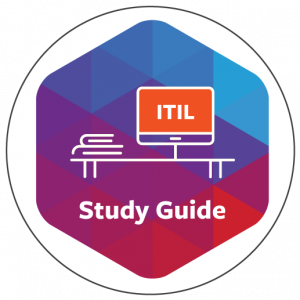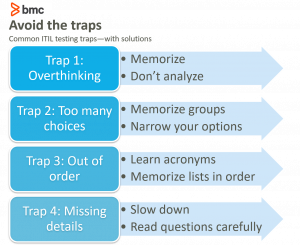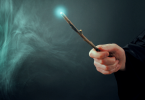ITIL Foundation is the entry level certification that demonstrates an awareness of key ITIL concepts and practices, as defined in the ITIL® 4 Foundation book. It is the prerequisite for any further ITIL certifications. Previous ITIL versions have seen over a million Foundation certificates awarded.
This article provides a study approach to the ITIL 4 Foundation Certification and it’s part of our ITIL 4 Guide, which you can navigate using the right-hand menu.
Download Now: ITIL 4 Best Practice e-Books
These all-new for 2020 ITIL e-books highlight important elements of ITIL 4 best practices. Quickly understand key changes and actionable concepts, written by ITIL 4 contributors.
What to expect on the Foundation Exam
To earn the ITIL Foundation certification, you must correctly answer 26 questions on a 40 question multiple-choice exam (65%). Each question will include 4 possible answers from which you must provide the best answer to the question. Each correct answer is awarded one mark.
The exam’s duration is 1 hour. Candidates taking the exam in a language that is not their native or working language may be awarded 25% extra time, i.e. 75 minutes in total. It is a “closed book” examination. No materials other than the examination materials are permitted.
The ITIL Foundation certification does not expire or require continuing education to maintain.
ITIL Foundation Exam Administration
You are not required to take an ITIL training course before you sit for the exam, but training is strongly recommended. If you are planning on earning higher level ITIL certifications, then it would be worthwhile to get formal training because it includes more detailed discussion on how the pieces fit together instead of just preparing you to pass the Foundation exam. SerView, VipCon, and BMC offer some training options.
Cost for taking the exam varies by country, with a typical expense of around $300. Training organizations usually include the cost for taking the exam in their course fee and can administer the exam right after training is complete.

You may take the exam at a testing center and some providers may also enable you to take the exam online without going to an exam center.If you choose this option, you must use a webcam. A proctor will greet you, walk you through the examination process, and then observe while you take the exam.
On completion of the online exam, the provisional score will be displayed on the screen after you fill out a post exam survey. Final scores and an e-certificate are available within two business days, while a hard copy certificate is available for shipping upon request (additional charges apply).
Exam Resources
Axelos is the worldwide manager of multiple best practice methodologies, including ITIL. They provide a number of resources for the exam, including books, sample exams, and exam apps. Axelos was formed in 2013 as a joint venture between the UK Cabinet Office and Capita PLC to manage, develop, and grow the Global Best Practice Portfolio.
ATOs: Accredited Training Organizations
Axelos works with PeopleCert as its sole exam provider and accreditation body. PeopleCert is authorized to provide training and administer examinations through training organizations that it has accredited worldwide on behalf of Axelos. ATOs provide both in person and online resources including classroom and online training and exams. More information about PeopleCert can be found on their website.
Exam Question Types
The ITIL Foundation exam questions are all Objective Test Questions (OTQs), which present four options from which one option is selected.
There are four question styles used within this OTQ type:
- Standard e.g. What is a service?
- Missing word e.g. Keep it __________ and practical.
- List (2 correct items) e.g. Which statement is correct? 1, 2, 3, 4. Choices – A: 1&4 B: 2&4 etc.
- Negative standard e.g. Which is NOT a type of change?
Negative standard questions are used as an exception and are therefore used sparingly in exams.
General Examination Tips
- You are not penalized for wrong answers. If you have drawn a blank, choose an answer to give yourself a chance.
- Drop perfectionism. The exam is pass/fail. There is no bonus credit for answering more than 26 questions correctly.
- Tips for checking your answers before submitting your exam:
- Read through each question to make sure you did not fall into any traps.
- Count how many answers you are sure you have gotten correct. If you have more than 26, then submit the exam. If you are a cautious person, submit the exam when you have more than 28 correct.
Key to Success: Avoid the Traps
The ITIL Foundation exam has a high pass rate. Statistics published in 2013 show a 90% pass rate, and many training providers advertise a 99% pass rate. Those who avoid the key traps will succeed on the exam.

Trap #1: Overthinking
How to avoid the trap: Memorize, don’t analyze.
The exam is multiple choice and testing basic knowledge of ITIL best practices. Memorize high-level concepts and definitions and stay focused on those concepts and definitions. Do not think about how your company does a particular process. Do not think about how you would improve the process. Just answer based on the ITIL materials.
Example: What is an emergency change?
| A | A change that is subject to expedited risk assessment because it is required to resolve an incident. |
| B | A change that doesn’t need risk assessment because the procedure has been pre-authorized. |
| C | A change that needs to be assessed, authorized, and scheduled by a change authority. |
| D | A change that is assessed, authorized and scheduled as part of ‘continual improvement’. |
The answer is A. Three of the four of the answers are related to types of change, but only A is the correct definition of an emergency change. Answer B is a standard change while C is a normal change. D is not a type of change specified by ITIL.
Trap #2: Too many choices
How to avoid the trap: Memorize groups
Some questions offer 2 or more options that may be correct. The answers will involve various combinations of those options, and only one combination is correct. The simplest version of this question is to present two options and offer these four potential answers: #1 only, #2 only, both, or neither. Frequently, there will be 4 options and 4 combinations presented.
Trap #3: Out of order
How to avoid the trap: Learn acronyms. Memorize lists in their correct order.
It’s not always enough to know the items in a list. If they are presented in a particular sequence or represented by an acronym, then it is crucial to know the correct order. Knowing the sequence makes the difference between an easy answer and a wild guess.
Example: What is the correct sequence within the continual improvement model?
| A | Where are we now? Where do we want to be? Did we get there? |
| B | Where do we want to be? Take action. Did we get there? |
| C | What is the vision? Where do we want to be? Did we get there? |
| D | How do we get there? Take action. Did we get there? |
The answer is D. It lists steps 4, 5 and 6 of the continual improvement model in the correct sequence.
Trap #4: Speed reading
How to avoid the trap: Read each question carefully.
Some questions are worded in a way that would trip up someone who did not read every word of the question. Do not read the first few words and jump down to the answers. Each question has some keywords that will either make the right answer obvious or quickly eliminate one or more possible answers.
Two common ways to trap speed readers are:
- Asking for the best answer or the answer that most closely Some questions provide word-for-word definitions, while others include a slight change. In some cases, there may be two possible answers that are nearly identical. You’ll need to read the answers to discover the difference between the two answers and choose the correct one.
Example: The BEST definition of an event is:
| A | An occurrence where a performance threshold has been exceeded and an agreed Service Level has already been impacted. |
| B | An occurrence that is significant for the management of configuration items or delivery of services. |
| C | A known system defect that generates multiple incident reports. |
| D | A planned meeting of customers and IT staff to announce a new service or improvement program. |
The answer is B. The first answer is part of Service Level Management . C is a known error and is handled by Problem Management. The planned meeting described by D is part of Release and Deployment Management.
- Using negative descriptors, such as NOT or EXCEPT. Instead of choosing the correct answer, you will be asked to choose the incorrect answer.
Example: Which of the following is NOT a service management practice?
| A | Business analysis |
| B | Change control |
| C | Release management |
| D | Knowledge management |
The answer is D. A, B and C are service management practices, while knowledge management is a general management practice.
As you read more practice questions, you will recognize the keywords that can easily point to the correct answer or eliminate possible distractors. Memorizing the material in its proper order and understanding how exam questions are worded are the biggest keys to success.
What to study
Please note: This is not a comprehensive list. The purpose of this summary is to highlight the areas of focus for question that appear on the ITIL Foundation Certification exam.
For a more comprehensive listing, download the Foundation Syllabus from the Axelos site if it has not been included with your training materials. Axelos provides this syllabus to ensure that ATOs cover the appropriate material in their training. If you are doing self-study, the suggested training timeframes help you prioritize what material to study and how much time to spend studying each topic.
As of April 2019, the Foundation syllabus breaks down levels of understanding into Awareness and Comprehension according to Bloom’s Taxonomy of learning which is used to categorize learning objectives, and from there assess learning achievements. Awareness topics do not go in-depth, so in most cases they can be addressed by memorizing key definitions. Comprehension topics require a deeper level of knowledge and will require more understanding. Comprehension goes beyond memorizing definitions and includes understanding why and how the concept impacts the business.
In the ITIL Foundation exam, the number of questions according to Bloom’s Taxonomy is as follows:
| Blooms Taxonomy Level | Number of Questions [Percentage] |
| BL1: Awareness | 9 [22.5%] |
| BL 2: Comprehension | 31 [77.5%] |
The ITIL Foundation exam syllabus can be summarized as follows:
| No. | Learning Outcome | Assessment Criteria | No of OTQs [%] |
| 1 | Understand the key service concepts | Definitions and concepts: (Service, Utility, Warranty, Customer, User, Service management, Sponsor, Cost; Value, Organization, Outcome, Output, Risk, Utility, Warranty; Service offering, Service relationship management, Service provision, Service consumption) | 5 [12.5%] |
| 2 | Understand how the ITIL guiding principles can help an organization adopt and adapt service management | Describe nature, use and interaction of the guiding principles: (Focus on value; Start where you are; Progress iteratively with feedback; Collaborate and promote visibility; Think and work holistically; Keep it simple and practical; Optimize and automate) | 5 [12.5%] |
| 3 | Understand the four dimensions of service management | Describe the four dimensions: (Organizations and People; Information and Technology; Partners and Suppliers; Value streams and Processes) | 2 [5%] |
| 4 | Understand the purpose and components of the ITIL service value system | Describe the ITIL SVS: (Guiding principles, Governance, Service value chain, Practices, Continual improvement) | 1 [2.5%] |
| 5 | Understand the activities of the service value chain, and how they interconnect | Describe inputs, outputs and purpose of each value chain activity: (Plan, Improve, Engage, Design & transition, Obtain/build, Deliver & support) | 4 [10%] |
| 6 | Know the purpose and key terms of 18 ITIL practices | Recall purpose of the 18 ITIL Practices: (Information security management; Relationship management; Supplier management; Availability management; Capacity and performance management; IT asset management; Service continuity management; Monitoring and event management; Release management; Service configuration management; Deployment management; Continual improvement; Change control; Incident management; Problem management; Service request management; Service desk; Service level management)
Recall definitions of 8 key ITIL Terms: (Availability, IT asset, Event, Configuration item, Change, Incident, Problem, Known error). | 7 [17.5%] |
| 7 | Understand 7 ITIL practices | Explain the 7 ITIL Practices in detail including how they fit in the value chain: (Continual improvement; Optimize and automate; Change control; Incident management; Problem management; Service request management; Service desk; Service level management) | 16 [40%] |
Conclusion
To obtain the ITIL Foundation Certification, you must answer at least 26 out of 40 multiple-choice questions on the examination. Focusing on the key topics (that have highest OTQ percentage) and memorizing the listed ITIL concepts and terms will lead to success. Good luck on the examination!
ITIL® is a registered trade mark of AXELOS Limited. IT Infrastructure Library® is a registered trade mark of AXELOS Limited.








